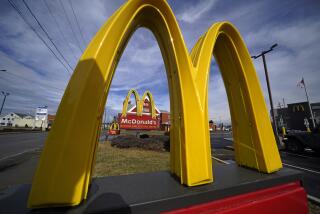What we know about the McDonald’s Quarter Pounder E. coli outbreak

- Share via
About 50 people have been reported infected in an E. coli outbreak involving McDonald’s Quarter Pounder sandwiches.
Here is what you need to know:
Where have the outbreaks occurred?
The outbreak began around Sept. 27 and no infections have been reported in California as of yet. But in addition to Nebraska and Colorado, infections have been confirmed in Oregon, Montana, Wyoming, Utah, Kansas, Missouri, Iowa and Wisconsin.
So far, around 50 people have been reported infected, with 27 infections occurring in Nebraska and nine in Colorado, according to the CDC.
Officials estimate that the actual number of people infected is probably much higher as it usually takes three to four weeks to determine if a sick person is part of an outbreak, and also because many people recover without being tested for E. coli.
What is McDonald’s doing?
In response, the fast food chain has proactively removed the onions and patties used for the burgers from stores in the affected states, according to the CDC. As a result, Quarter Pounder hamburgers will be temporarily unavailable in some states.
How does E. coli spread?
Most instances of E. coli contamination are caused by poor sanitation practices, such as employees not washing their hands, crops being grown too close to farms where animals live and contaminate the soil and runoff with feces, and companies’ failure to properly process and test foods, according to Teresa Murray, consumer watchdog director for the Public Interest Research Group.
One of the last major E. coli outbreaks took place in 2015, when contaminated food served at Chipotle Mexican Grill restaurants was linked to around 60 cases across the nation, including several in California.
What are signs of illness?
The CDC offered these tips:
Call your healthcare provider if you have severe E. coli symptoms:
- Diarrhea and a fever higher than 102 degrees
- Diarrhea for more than three days that is not improving
- Bloody diarrhea
- Diarrhea for more than three days that is not improving
- So much vomiting that you cannot keep liquids down
- Signs of dehydration, such as:
- Decreased urination
- Dry mouth and throat
- Feeling dizzy when standing up
- Decreased urination
Symptoms of E. coli
- Most people infected with Shiga toxin-producing E. coli experience severe stomach cramps, diarrhea (often bloody), and vomiting.
- Symptoms usually start three to four days after ingesting the bacteria.
- Most people recover without treatment after five to seven days.
- Symptoms usually start three to four days after ingesting the bacteria.
- Some people may develop serious kidney problems (hemolytic uremic syndrome, also called HUS) and would need to be hospitalized.
More to Read
Sign up for Essential California
The most important California stories and recommendations in your inbox every morning.
You may occasionally receive promotional content from the Los Angeles Times.











